This is a Takane Mine Six Super 66, a folding rangefinder camera made by Takane Kogaku K.K. in 1957. The Mine Six Super 66 shoots 6cm x 6cm or 4.5cm x 6cm images on 120 roll film and has a coupled coincident image rangefinder, an uncoupled selenium exposure meter, and featuring Asahi Kogaku Takumar lenses, making it one of the higher spec cameras of it’s type. The company who made it was a short lived optical company based out of Takasaki, Japan who despite being around a short time, earned a reputation as making high quality Japanese cameras. The Takane Mine Six was part of a series of cameras made by the company, but with the increasing preference for 35mm cameras at the end of the 1950s caused financial difficulties with the company, causing them to go out of business in 1958.
Film Type: 120 Roll Film (twelve 6cm x 6cm or sixteen 4.5cm x 6cm exposures per roll)
Lens: 7.5cm f/3.5 Asahi-Kogaku T-Takumar coated 4-elements in 3-groups
Focus: 3.5 feet to Infinity
Viewfinder: Coincident Image Coupled Rangefinder
Shutter: Copal MXV Leaf
Speeds: B, 1 – 1/500 seconds
Exposure Meter: Uncoupled Selenium Cell w/ Top Plate Match Needle
Battery: None
Flash Mount: Cold shoe and M and X Flash Sync
Other Features: Self-Timer, Removable Baffles for 4.5×6 Images
Weight: 850 grams
Manual: None
History
The history of the Japanese camera industry is full of dozens, possibly even hundreds of small camera makers that started producing cameras or some form of optical products in the 1950s. Many of these companies came and went with little fanfare, and very few of them were ever exported out of Japan, making a huge number of them completely unheard of in western countries like the United States.
For many of these short lived companies, the cameras they produced were cheap and unmemorable. Many using “Hit style” 17.5mm subminiature film, some using a variant of 35mm film called Bolta film, and some even using regular 35mm and 120 roll film.
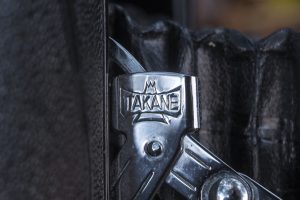
On occasion though, one of these short lived companies actually produced something that was good…actually, quite good! Such was the case of Takane Kogaku. Referred to in Koichi Sugiyama’s The Collector’s Guide to Japanese Cameras as Takamine, the company who would eventually become Takane was started in 1952 by a man named Izawa who produced optical components for other companies. One of Izawa’s biggest customers was Mihama Seikō who made a 6×6 folding camera called the Mihama Six which Izawa constructed the bodies for.
A year after starting his new company, Izawa wanted to expand into making his own camera, but lacking in the financial resources to do it himself, he borrowed money from Gunma Daidō Bank on the Gunma Prefecture of Japan. To show gratitude for the support given to him by the bank, Izawa renamed his new camera company Daidō Seikō and started work on a copy of the original Mihama Six, which he called the Daido Six. Along with the Daido Six, a smaller Semi Daido was released in December 1953.
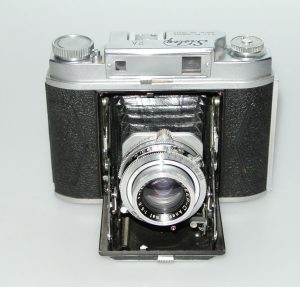
Shortly after the release of the two Daido cameras, the company name would change once again to Takane Kōgaku. The word “takane” means “lofty peak” and was consistent with other mountain themed Japanese camera makers like Olympus and Fuji. As Takane, the company’s first new camera was called the Takane Sisley and was released in May 1954. The Sisley used a similar design and style to the earlier Daido Six, but added an uncoupled rangefinder and new cosmetics. The Sisley was sometimes sold as the Sisley Model 1, Sisley 55, and Balm Six.
Although capable models, the Sisley offered nothing new compared to many other very similar Japanese folding cameras produced at the same time, so Izawa set his sights higher and started work on an all new camera.
Employing the talents of precision engineers and designers that he admired from companies like Konishiroku (Konica), Asahi (Pentax), and Zunow, work began on a new camera series called the Mine Six. With the Mine Six came some new innovations such as front unit focus in which focusing the camera rotated the entire lens assembly, rather than just the front element group. Later models in the series added a coupled rangefinder, automatic stop film advance, more advanced Copal shutters, and Asahi Takumar lenses.
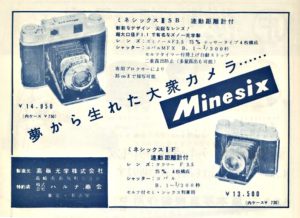
While each of these features likely seemed like a natural evolution of the Mine Six’s design, it would seem that Takane’s methods for implementing new features infringed on patents by other Japanese companies. With the release of the Mine Six IIISB in 1956, the company drew complaints by Aires, Konishiroku, and Mamiya who said Takane’s rangefinder coupling, image, and viewfinder bright lines violated each company’s existing patents. Takane’s chief designer, Takamatsu Kingo would later admit that he drew inspiration from other company’s designs and anything he liked, he would adopt into his own camera, without any concern for patent infringement.
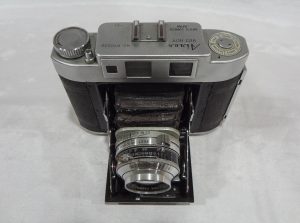
It is not clear how Takane resolved their complaints from Konishiroku or Mamiya, but an agreement would be made with Aires in which Takane agreed to manufacture the body for the Aires Viceroy 6×6 folding camera in exchange to keep using what they copied from Aires’s design.
Now making some of the best Japanese 6×6 folders, in 1957, Takane would release the Mine Six Super 66, a redesigned camera with what would be the only camera of it’s type with a selenium exposure meter. The meter itself was sourced from Japanese electronics company called Kuwano Denki who sent their own workers to Takane to help them integrate the meter into their camera.
When it was released in 1957, the Mine Super 66 was one of the most advanced 6×6 folding cameras produced by any company in the world. Sales of the Super 66, IISB, and IIF were strong, and the company seemed to be poised for future success, but a sudden collapse of Takane’s primary distributor resulted in a huge number of orders to be cancelled.
With an inability to distribute Takane’s models and an industry shift away from medium format folding cameras, Izawa realized that Takane could no longer survive and in 1958 closed the company.
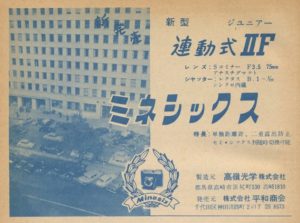
After the company’s dissolution, chief designer Takamatsu Kingo returned to teaching, which is what we did prior to joining the company. Several other workers sought employment from other Japanese optics companies, but there is no information about what company founder, Mr. Izawa did.
Today, it is hard to state the desirability of Takane cameras. For many collectors, both experienced and not, the 1950s Japanese photo industry was very confusing. A huge number of companies sprang up over night, and almost as quickly as they appeared, they were gone again.
Few however, were as short lived while still making quality cameras as Takane. While this Mine Six Super 66 is the only one I’ve handled, I have no doubt that others in the series are worth checking out if you have the chance. I won’t go as far to recommend anyone seek out this specific model simply because of it’s rarity, but if you are lucky enough to come across one, you could do a lot worse!
Repairs
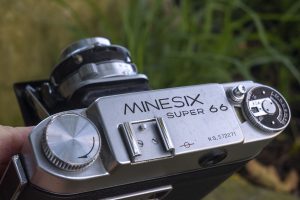
This camera came to me completely inoperable. The shutter was stuck, the focus helix was frozen, and because the focus couldn’t move, the rangefinder didn’t either. With a lesser camera, I might have tried to fix this myself as I have had limited luck in cleaning and lubing helixes and flushing shutters, but the rarity of this camera made me nervous.
The final nail in the coffin was when another collector gave me an offer I couldn’t refuse for a bucket list camera he had been looking for, so I ended up selling it to him. In the months since passing on the Takane to it’s new owner, I went back and forth regretting my decision, but in the end, I have enough other cameras to keep me busy, so it wasn’t a huge loss.
My Thoughts
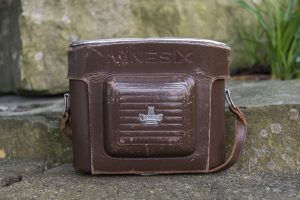 Having reviewed both the Super Fujica-6 and Suzuki Press Van, I had started to become spoiled with premium 6cm x 6cm Japanese folders. Both of those cameras were near the peak of their respective genres in build quality, features, and performance. The only downside to those two cameras were they were both loaners which I had to return when my time to review them completed.
Having reviewed both the Super Fujica-6 and Suzuki Press Van, I had started to become spoiled with premium 6cm x 6cm Japanese folders. Both of those cameras were near the peak of their respective genres in build quality, features, and performance. The only downside to those two cameras were they were both loaners which I had to return when my time to review them completed.
I had sought out a premium Japanese 6×6 folder of my own and when I saw the chance to pick up this Takane Mine Six Super 66, I couldn’t wait to get my hands on it!
When it arrived, as expected, the Takane was a sight to behold. Bigger than simpler 6×6 folders like the Voigtländer Perkeo II or the ANSCO B2 Commander, the Takane is large and heavy. Weighing in at 850 grams, it is 311 grams heavier than the Perkeo and only 5 grams less than the KMZ Iskra, which remains the heaviest 6×6 folding camera I’ve ever handled.
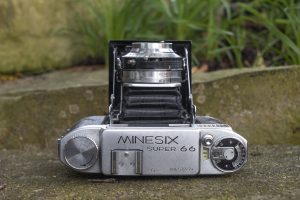
The top plate is dominated by a large engraved Mine Six Super 66 logo, flanked on the left by the film wind knob and both the cable threaded shutter release button, exposure meter readout, and ASA film speed selector on the right.
The selenium exposure meter is uncoupled, whcih means that changes to the camera’s shutter speeds and aperture have no effect on the readout.
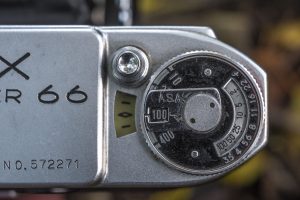
To use the meter, you must first set the film speed to whatever is loaded in the camera, and then point the meter at whatever subject you’d like to measure.
Turn the outer dial of the meter until a needle inside of the display lines up with the diamond symbol in the center. With the needle on the diamond, manually setting any combination of shutter speeds and apertures on the right side of the dial will give you proper exposure. In the image to the right, the meter wasn’t working, but if it was, and the needle was pointing at the diamond, 1/100 and f/3.5 or 1/10 and f/11 would both give proper exposure.
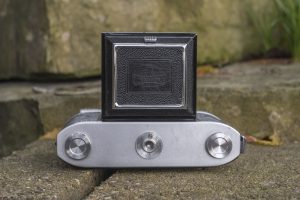
The bottom of the camera has a centrally located 1/4″ tripod socket and two round feet that are also used to pull out the posts inside of the film compartment for loading film into the camera. Also, notice the Takane logo embossed into the body covering on the front door of the camera that is normally seen when the camera is folded shut.
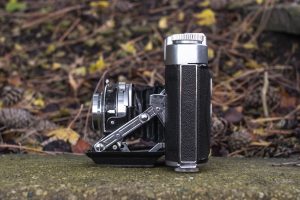
The camera’s sides are pretty much the same with the only difference being the film door release latch on the left side. Simply slide down the latch near the bottom of the side and the right hinged film door swings open. A lack of strap lugs means that you’ll either need to use the original leather case or something attached to the tripod socket if you want to connect a neck strap.
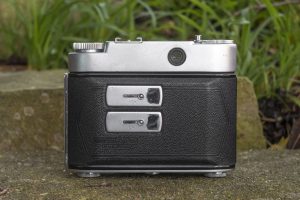
Around back, there’s the round opening to the large viewfinder and two sliders on the door for seeing the exposure numbers for either 4.5cm x 6cm or 6cm x 6cm images. Earlier Takane Mine Six cameras had an automatic stop film advance, but this feature was removed on the Super 66 because it was deemed to be too complex.
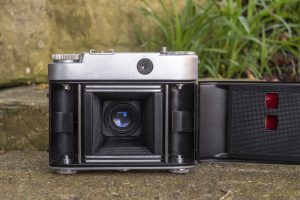
With the film door open, we see the Mine Six’s film compartment. Film transports from right to left using standard 120 spools. When this camera was new, an optional mask for 4.5cm x 6cm images would have been included with the camera to allow you to shoot that format. When loading film into the camera, the two posts on the bottom of each chamber can be pulled down using the feet on the bottom of the camera to make getting the spools in there easier.
The film pressure plate is covered with a series of divots which reduces friction as film passes over it. Inside of the pressure plate are the two openings for the exposure numbers visible on the back of the camera.
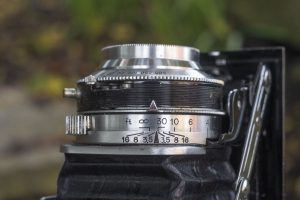
All exposure and focus controls for the Takane Mine Six Super 66 are visible from the top of the shutter. A lever behind the shutter moves the helicoid mount from minimum to infinity. This style of focus is ideal compared to lesser folding cameras as the entire lens moves fore and aft instead of rotating like on front cell or unit focus cameras.
Immediately in front of the focus ring is a small ring that is supposed to point to the aperture f/stops of the lens, but on this example, the plate is missing. Had I been able to use this camera, the little pointer would have moved left or right from f/3.5 to probably f/22.
Finally a ring nearest the front of the lens is used to change shutter speeds from 1 to 1/500 seconds plus Bulb. This works like it does on pretty much every other leaf shutter camera.
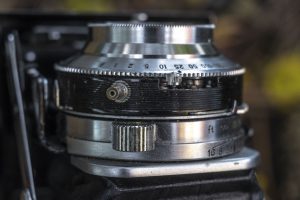
Opposite the side showing the focus distances you get a better look at the handle for the focusing helicoid, along with the flash sync connector immediately behind it.
To the right of the flash sync connector is an arm for cocking the shutter. The Takane Mine Six Super 66 does not have a coupled film transport, so this step must be done to cock the shutter before each exposure.
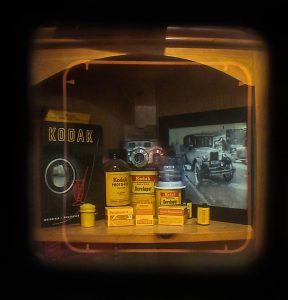
The viewfinder is large and bright, showing projected frame lines with both parallax correction hash marks and marks indicating a 4.5cm x 6cm images when using the mask, near the corners. The square rangefinder patch has a pink hue to it, giving it a good amount of contrast from the rest of the image.
Not having a chance to shoot any film through the Takane, I feel as though this viewfinder would have given me the best possible chance at getting great images.
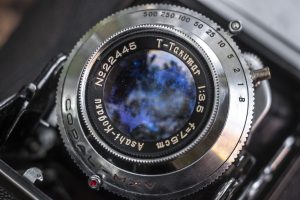
So far in this review, I’ve spoken about the quality of the Takane produced camera, but without a doubt, one of it’s greatest attributes is the Asahi-Kogaku T-Takumar lens attached to it.
This and the Suzuki Press Van are the only two medium format cameras I’ve had a chance to review with a Takumar lens, and based not only on that one example, but Asahi’s entire reputation of all Takumar lenses, I have no doubt that the images I could have gotten from this camera would have been excellent.
As best as I can tell, this is a 4-element in 3-groups design, that is probably based off the Tessar. The deep blue coating would have likely controlled flare well with excellent color rendition. In an era of vivid color slide film, images shot through the Takane Mine Six Super 66 probably would have been some of the best 6×6 images out there.
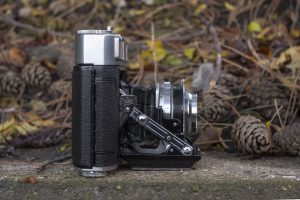
In the days after receiving the Takane, handling it, and getting used to it’s controls, I grew increasingly disappointed in it’s condition. This was a camera that I very much wanted to try out, and I definitely struggled with the thought of sending it to someone for a full CLA.
Even without the ability to put some film through the camera, my experiences with other quality made 6×6 folding cameras, I felt as though I had a pretty good idea of what shooting the camera would have been like.
The Takane Mine Six Super 66 is a well built and heavy camera. The camera’s coupled rangefinder and exposure meter add not only weight, but size making this a camera that wouldn’t fit easily into a pocket or small bag. When folded shut, it is quite a bit smaller than a medium format TLR, but you’d definitely notice it hanging from a strap around your neck on a long hike through the woods.
The viewfinder is excellent, as good as I’ve ever seen on a camera of this type, but the exposure meter, while nice to have, isn’t quick to use. Uncoupled meters are essentially like having an external meter that’s permanently attached to the camera. Had I been a photographer in the late 1950s looking for folding camera with a meter, I probably would have preferred using a hand held Weston or Sekonic meter instead of the tiny one on the Takane’s top plate.
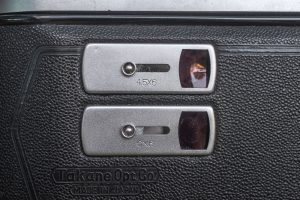
Ergonomics are good, the focus helix, the shutter, and the lens are all great, suggesting that if you struggled to get great images from this camera, you might need to look in a mirror to troubleshoot your problem.
Sadly, as I’ve sure you’ve noticed a lack of sample photos shot through the Takane, this camera came to me in inoperable condition. In addition to the shutter being seized up, the focus helix was also rock hard, suggesting it’s original lube had dried up into a cement like substance. Normally, when I encounter a leaf shutter camera with a stuck shutter, I take it apart in an effort to get it going, but had I done that, I would have had to address the focus helix, which I was not prepared to do.
This camera was in cosmetically excellent condition, and not wanting to risk damaging the camera by taking it apart, I found a collector who had no interest in shooting it and just wanted to display it on it’s shelf, so off it went, with me never having shot a single exposure through the camera. I am unsure of what other opportunities I might have to shoot another camera like this, but if given the chance, I will definitely take it as I recommend you should too.
Related Posts You Might Enjoy
External Links
http://camera-wiki.org/wiki/Mine_Six
http://web.archive.org/web/20160331123539/http://arukucamera.net/TakaneSuper66.html
http://oldgoodlight.blogspot.com/2017/05/takane-mine-six-iif.html


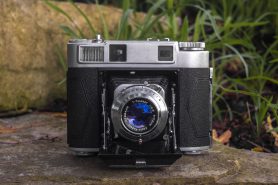
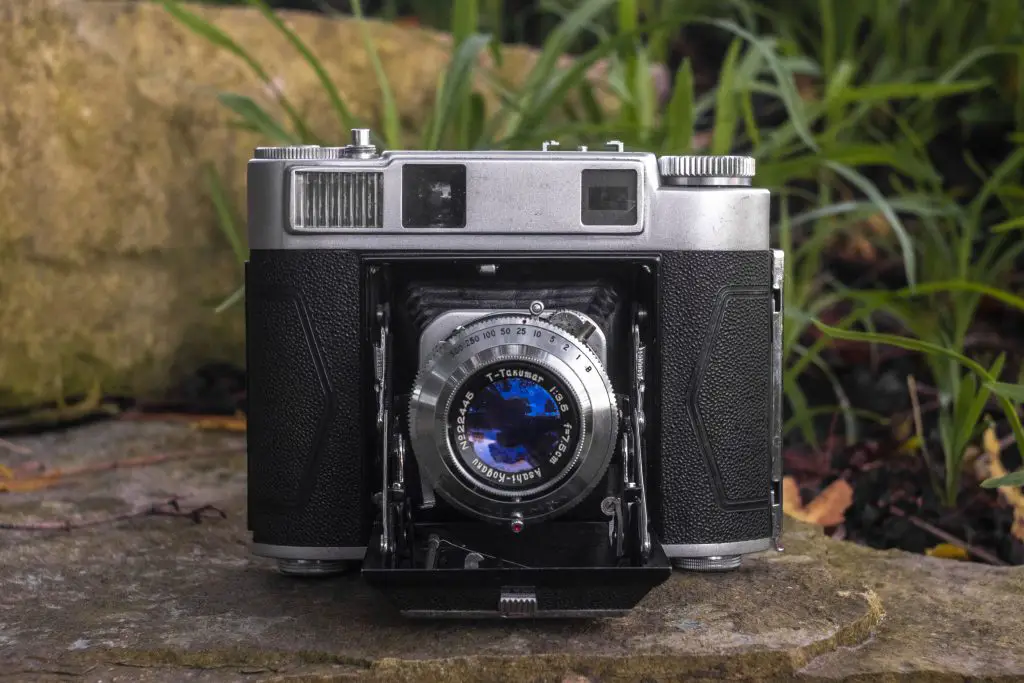
I have a number of the Takane Super 66’s and two with working meters,even. Also a couple of the Minesix IIIs with the Zuminor lens, and a IIF with the same Asahi T-Takumar. From all I have read there is discussion that these are three element lenses, but no one has ever definitively ever disassembled one, to say whether it is or a 4 element Tessar style. I totally agree this series is my favorite Med format Japanes folder, although the last version of the Mamiya Automat gives it a run for the money. Love this camera….
I see a pattern developing Mike. You have to get myself and Eric Kaas Sluis on the podcast to discuss 120 folders. I shot my Balda Super-Baldax and Konica Pearl IV on recent holiday and soon as I get shots developed will review them on CasualPhotophile.
I picked up a Daido-Seiko recently and hope to get it working. Thanks for your informative article!
I have a Minesix super 66 which I am not sure how it works or if it works. Appears to be in good condition from looking at outside. Want to sell. Have any recommendations on how or where to go about selling it?